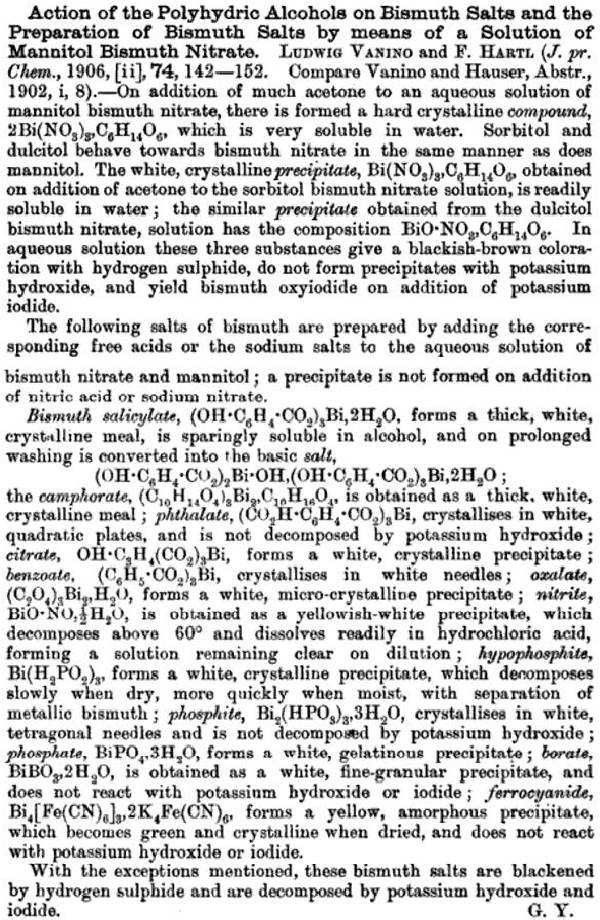

 And only about 3 - 4 g of bismuth was dissolved in it. So needless to say it took
awhile and heated up, and boiled, because I was adding solid KOH due to the fact that I was using my largest beaker with only a 300 ml volume. About
50g of KOH later, the yellow solution became colloidal but was still acid to luminous. Added more KOH and all at once the precipitate turned cream
color and was now distinctly basic, pH > 14. The precipitate was settling rapidly when I put away the mixture for today. Tomorrow, filter and
wash with dilute KOH and possibly heat off the water.
And only about 3 - 4 g of bismuth was dissolved in it. So needless to say it took
awhile and heated up, and boiled, because I was adding solid KOH due to the fact that I was using my largest beaker with only a 300 ml volume. About
50g of KOH later, the yellow solution became colloidal but was still acid to luminous. Added more KOH and all at once the precipitate turned cream
color and was now distinctly basic, pH > 14. The precipitate was settling rapidly when I put away the mixture for today. Tomorrow, filter and
wash with dilute KOH and possibly heat off the water.
| Quote: |
| Quote: |

| Quote: |

 <sub>3</sub>
<sub>3</sub> was placed into a steel crucible and heated for several minutes over a propane torch. Steam was released and the color of the material
lightened to almost white, though it was a little difficult to tell since there was some carbon powder left in the crucible from a previous
experiment. After I was confident it was dehydrated I added a few pellets of solid KOH. They didn't do much or dissolve until suddenly they fizzed
and popped and melted very rapidly, possibly exothermically (a reaction with the bismuth materials in the crucible?) Within minutes the suspension of
material in the liquid KOH had turned green/yellow and the solution itself looked green. I let this continue for an hour stirring from time to time
with a nickel rod (the liquid KOH was green before I started stirring it with the nickel rod).
was placed into a steel crucible and heated for several minutes over a propane torch. Steam was released and the color of the material
lightened to almost white, though it was a little difficult to tell since there was some carbon powder left in the crucible from a previous
experiment. After I was confident it was dehydrated I added a few pellets of solid KOH. They didn't do much or dissolve until suddenly they fizzed
and popped and melted very rapidly, possibly exothermically (a reaction with the bismuth materials in the crucible?) Within minutes the suspension of
material in the liquid KOH had turned green/yellow and the solution itself looked green. I let this continue for an hour stirring from time to time
with a nickel rod (the liquid KOH was green before I started stirring it with the nickel rod).  ...oops), a few problems with it as an oxidizing agent are apparent, first its insolubility in water, and secondly its very high molar
mass, it took over 4.5g of bismuthate(91.8%, technical) to oxidize 1g Mn(OAc)2 to permanganate. Would take quite a bit for most oxidations. I added
some sodium carbonate to the bismuth containing insoluble reduction product, hoping for bismuth subcarbonate, which should help determine whether
Bi2O3 or BiO+ or Bi3+(likely just as intermediate) is formed(I hope).
...oops), a few problems with it as an oxidizing agent are apparent, first its insolubility in water, and secondly its very high molar
mass, it took over 4.5g of bismuthate(91.8%, technical) to oxidize 1g Mn(OAc)2 to permanganate. Would take quite a bit for most oxidations. I added
some sodium carbonate to the bismuth containing insoluble reduction product, hoping for bismuth subcarbonate, which should help determine whether
Bi2O3 or BiO+ or Bi3+(likely just as intermediate) is formed(I hope). <sub>3</sub> + 3NO<sub>2</sub> + 3H<sub>2</sub>O
<sub>3</sub> + 3NO<sub>2</sub> + 3H<sub>2</sub>O
Quote: Originally posted by IrC  |
| Quote: |
Quote: Originally posted by IrC  |